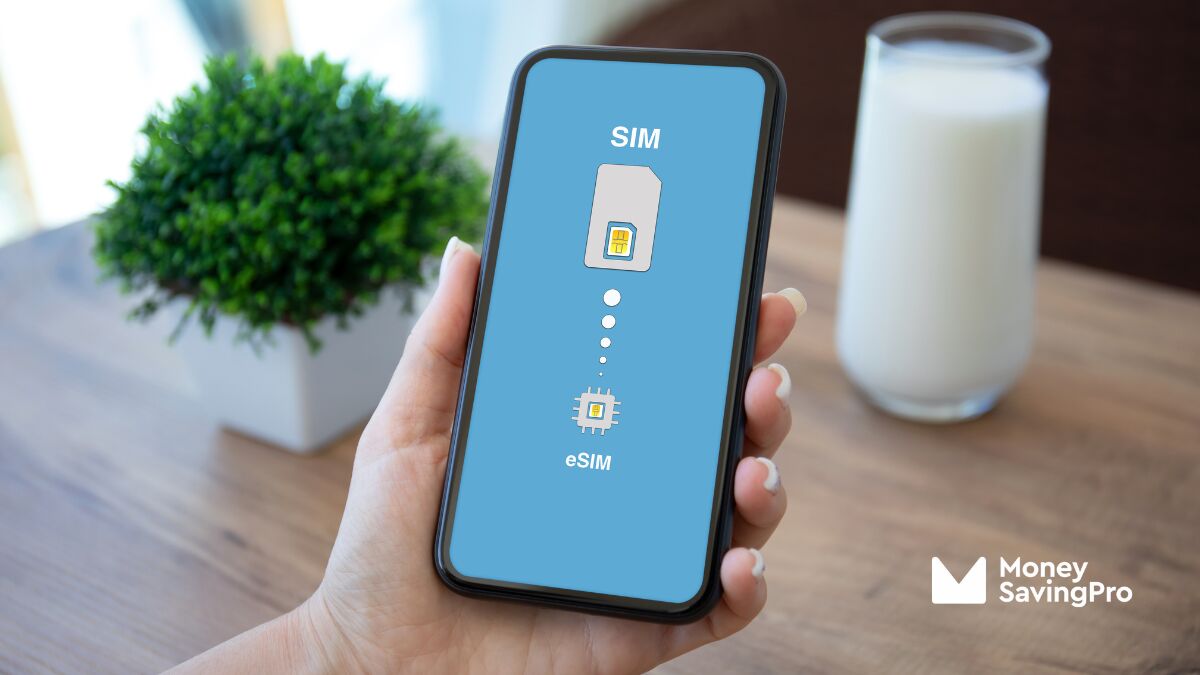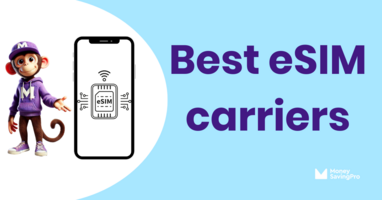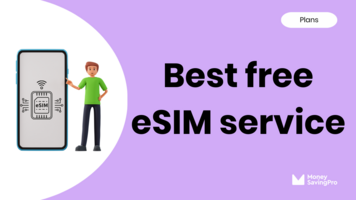
In the world of cell phones, two terms have been buzzing around lately: eSIM and physical SIMs.
But what exactly are these, and how can they impact your wallet?
I'm here to break down the differences between eSIMs and physical SIM cards to help you take a closer look at your options. That way, if you choose to make a change, you can make a smart switch that can save you both money and hassle.
What is an eSIM?
Imagine a SIM card but without the physical plastic card itself. An eSIM (embedded SIM card) is a digital chip that's built right into your phone.
It's like having a SIM card but in virtual form.
This means no more fumbling around with tiny pieces of plastic or trying to find a paper clip to open the physical SIM slot – everything is managed electronically.
How does an eSIM work?
eSIM technology works just like a traditional SIM card, enabling your phone to connect to a cellular network.
The key difference is that you don't need to insert or remove anything physically. Instead, you can switch between carriers and plans with just a few taps on your phone.
This can be a real game-changer for those who frequently travel or want to explore new, cost-effective plans.
What's the difference between an eSIM and a physical SIM?
Physical SIM card:
- Physical insertion: You need to insert and remove the SIM card from your phone by hand. This can be beneficial if you damage your phone. You can remove your SIM card and put it into an old handset while waiting for repairs or to get an upgrade.
- Limited slots: Your phone has a limited number of slots for SIM cards, making switching carriers less convenient.
- SIM replacement: If you lose or damage your SIM card, you'll need to visit a store or wait for your carrier to mail a replacement.
- International travel: Swapping SIM cards in a foreign country can be challenging and costly.
eSIM:
- Easy switching: Switch carriers and plans digitally without needing a physical card.
- Multiple profiles: Depending on the carrier or phone, you can store multiple carrier profiles on a single eSIM, making switching a breeze.
- Remote activation: Activate an eSIM remotely, eliminating the need for in-store visits or waiting by your mailbox.
- Save when traveling: Changing carriers while abroad is a snap. Connect to a local carrier to help cut the costs of expensive roaming fees.
- Personal & Business: Limit the need for more than one cell phone by adding your work and personal numbers onto one phone.
How have SIM cards evolved?
From standard-sized SIM (Subscriber Identity Module) cards to micro-SIM cards and nano-SIM cards, their sizes have shrunk, making more room for phone innovation.
But even these tiny physical cards can be a hassle to swap out, especially if you're someone who likes switching phones or experimenting with different carriers.
Prepaid eSIM are the future of both phone manufacturers and network providers.
What is a dual SIM phone?
A dual SIM is a feature found in certain newer phones that allows them to hold and operate with two separate SIM cards simultaneously.
So essentially, you have two phone lines on one device. This type of versatility is ideal if you want a separate business line or travel abroad regularly.
With a dual SIM phone, you can have two different SIM cards using two separate plans from the same carrier or plans on two different networks on the same device. eSIM phones streamline this benefit.
Depending on the phone, this can either mean two SIM card slots or one eSIM and one SIM card slot.
The advantages of using a dual SIM phone include:
- Convenience: You can keep separate phone numbers for different purposes without needing a different phone. For example, you can manage personal and business contacts on separate SIMs without carrying two phones.
- Cost efficiency: If you have access to multiple mobile networks with varying call and data rates, you can switch between SIMs to save money based on the situation.
- Roaming: When traveling, you can use a local SIM for data and calls while keeping your original SIM active for calls from home.
- Network coverage: If one network has better coverage in a specific area, you can switch to that SIM to ensure better connectivity.
- Try before you buy: Dual SIM allows you to try out a new carrier's network before ending your current phone plan. To make sure your new carrier's a good fit.
How do I activate an eSIM?
Activating an eSIM is simpler than you might think. Your carrier will give a QR code or an activation code. Follow these steps:
- Go to settings: Open your phone's settings menu.
- Find cellular or mobile: Look for the cellular or mobile option.
- Add cellular plan: Choose to add a new cellular plan.
- Scan QR code: Use your phone's camera to scan the provided QR code.
- Follow prompts: Follow the on-screen prompts to complete the activation.
eSIM vs SIM card FAQs
Yes. As long as your phone supports both eSIM and traditional SIM cards. Many phones still support both, but you'll need to contact your cell phone provider if you're looking to transfer your current plan back to a physical SIM card so they can mail it to you.
Yes, you can transfer your existing number to an eSIM, just like with a physical SIM card.
Which is better will depend on personal preferences. An eSIM makes it quick and easy to change carriers without having to wait for a SIM card to be sent in the mail. However, if something goes wrong with your phone, you won't be able to remove the eSIM and pop it into another phone.
You don't need to have a physical SIM card and an eSIM. However, some handsets offer a dual SIM, so you can have both, which can be beneficial if you need a separate number for work or for traveling abroad.
Recap
In a world where every penny counts, finding a cheap cell phone plan with an MVNO could help you save hundreds on your phone bill.
So, whether you're a frequent traveler, a tech enthusiast, or simply someone looking to save money, consider the difference between an eSIM and a traditional SIM card, depending on your personal needs.
With remote activation, the flexibility to switch carriers at will, and the ability to store multiple profiles, eSIM plans offer plenty of convenience. And it could just be the money-saving move you've been looking for.





